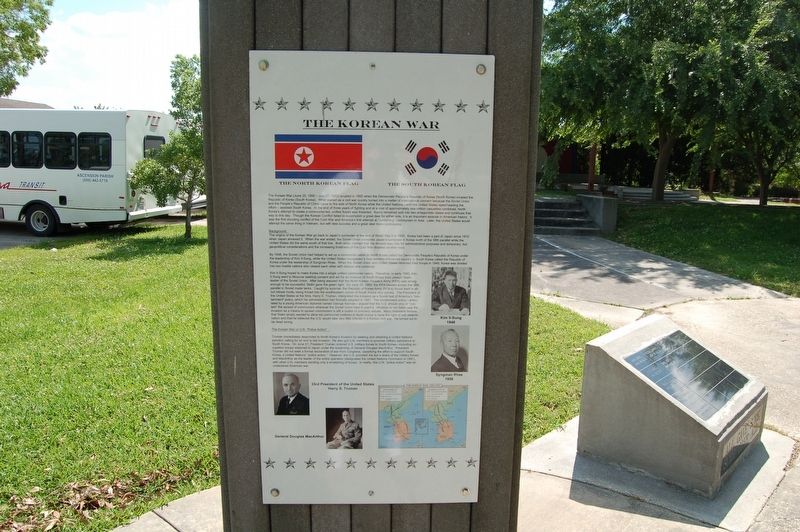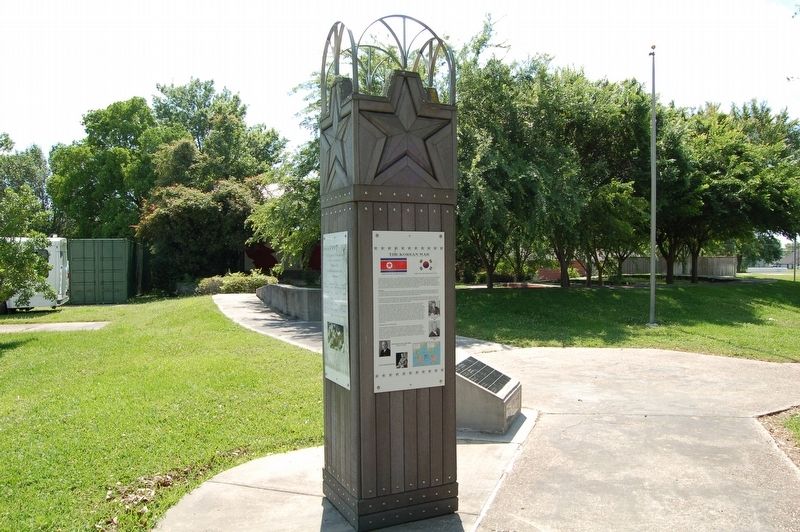The Korean War
The Korean War (June 25, 1950 - July 27, 1953) erupted in 1950 when the Democratic People's Republic of Korea (North Korea) invaded the Republic of Korea (South Korea). What started as a civil war quickly turned into a matter of international concern because the Soviet Union and the People's Republic of China came to the side of North Korea while the United Nations—with the United States spearheading the effort— assisted South Korea. At the end of three years of fighting and at a cost of approximately one million casualties combined, North Korea's attempt to create a communist-led, unified Korea was thwarted. Korea remained split into two antagonistic states and continues that way to this day. Though the Korean Conflict failed to accomplish a great deal for either side, it is an important episode in American history. It was the first shooting conflict of the Cold War and America's first attempt at "containing communism in Asia. Later, the United States would attempt the same thing in Vietnam, but with less success and a great deal more controversy.
Background
The origins of the Korean War go back to Japan's surrender at the end of World War II in 1945. Korea had been a part of Japan since 1910 when Japan annexed it. When the war ended, the Soviet Union accepted Japan's surrender
in Korea north of the 38th parallel while the United States did the same south of that line. Both sides claimed that the division was only for administrative purposes and temporary, but geopolitical considerations and the increasing frostiness of the Cold War dictated another road.By 1948, the Soviet Union had helped to set up a communist nation in North Korea called the Democratic People's Republic of Korea under the leadership of Kim Il-Sung, while the United States recognized a rival western-influenced country in South Korea called the Republic of Korea under the leadership of Syngman Rhee. When the Soviet Union and United States removed their troops in 1949, Korea was divided into two hostile nations who viewed each other with distrust and contempt.
Kim II-Sung hoped to make Korea into a single unified communist nation. Therefore, in early 1950, Kim II-Sung went to Moscow seeking consent and aid for an invasion of South Korea from Joseph Stalin, leader of the Soviet Union. After being assured that the North Korean People's Army (KPA) was strong enough to be successful, Stalin gave the green light. On June 25, 1950, the KPA blasted across the 38th parallel in Soviet made tanks. Caught by surprise, the Republic of Korea Army (ROKA) found itself in all- out retreat mode, being forced into the southeastern corner of South Korea very quickly. The President of the United States
at the time, Harry S. Truman, interpreted the invasion as a Soviet test of America's "containment” policy, which his administration had formally adopted in 1947. The containment policy—articulated by a young American diplomat named George Kennan—argued that the U.S. should stop or “contain” the spread of communism wherever the Soviet Union tried to plant it. Whether or not Stalin saw the invasion as a means to spread communism is still a matter of scholarly debate. Many historians believe that Stalin simply wanted to allow his communist brethren in North Korea to have the right of self-determination and that he believed the U.S. would take very little interest in a Korean civil war. He turned out to be dead wrong.The Korean War or U.N. “Police Action”
Truman immediately responded to North Korea's invasion by seeking and obtaining a United Nations' sanction calling for an end to the invasion. He also got U.N. members to promise military assistance to South Korea. On June 27, President Truman ordered U.S. military forces to South Korea—including occupation troops stationed in Japan under the leadership of General Douglas MacArthur. President Truman did not seek a formal declaration of war from Congress, classifying the effort to support South Korea, a United Nations' “police action." However, the U.S. provided the
lion's share of the military forces and MacArthur as the leader of the entire operation (designated the United Nations Command or UNC), with other U.N. members sending only a smattering of troops. In reality, this U.N. "police action” was an undeclared American war.The War Begins: Pushed Back to Pusan (June 25, 1950 - September 14, 1950)
After the North Koreans exploded across the 38th parallel on June 25, it took them only three days to reach the South Korean capital of Seoul where they hoped to see a quick surrender of Syngman Rhee's government and army (ROKA). No surrender came. The South Koreans continued to fall back and wait for American troops to arrive. Unfortunately, U.S. forces made little difference in the beginning of the war.
Inadequate numbers and the constant threat of guerilla attacks on American soldiers made America's first eight weeks in the war as helpers of the South Koreans not very helpful. By early September 1950, the North Koreans had driven back the UNC (United Nations Command) to a small defensive position in the southeastern corner of South Korea near Pusan.
To the 38th and Beyond and Back Again (September 15, 1950 – July 8, 1951)
The U.N.'s only official stated goal for the war was to repel the North Korean invasion back to the 38th parallel. By September, even that very limited
goal seemed in doubt. However, General Douglas MacArthur devised a brilliant yet risky plan—an amphibious landing behind enemy lines at Inchon, the port outlet of Seoul. MacArthur created the invasion force by combining the 1st Marine Division, part of the Eighth Army, South Korean marines and soldiers, and other assorted U.S. troops into a unit known as X Corps, which he placed under the command of his chief of staff, Major General Edward M. Almond. On September 15, 1950, the invasion of Inchon began and it was a tremendous success. By September 27, ROKA and U.S. forces had liberated Seoul. By October 1, the UNC had reclaimed most of South Korea below the 38th parallel.In only three months, the U.N. had achieved its goal of reestablishing the 38th parallel as the border, but the success at Inchon encouraged the U.N. to aim for a loftier goal. “The establishment of a unified, independent, and democratic Korea" became the U.N.'s new objective for the war. As a result, the U.N. authorized troops to cross the 38th parallel and conquer and occupy all of North Korea, but only if Korea's northern communist neighbors, the Soviet Union and China, did not intervene. China, led by communist leader Mao Zedong, had publicly proclaimed that it would not simply allow U.S. troops to approach the Yalu River—the border between North Korea and China—without consequence. General MacArthur thought it simply to be Chinese bluster, so he crossed the 38th to accomplish the mission. As it turned out, he was wrong about the Chinese.
After achieving great success through October and early November, which included seizing the North Korean capital of Pyongyang on October 17, American and ROKA forces began to close in on the Yalu River. But on November 25, true to their word, thousands of Chinese soldiers began pouring across the Yalu. In a very short time, they managed to push U.N. forces two-thirds the way back down the peninsula and south of the 38th parallel again. General MacArthur publicly began to blame the Truman Administration for limiting the war to Korea and not allowing him to bomb bases in China. MacArthur's public criticisms of his Commander-in-Chief led to one of the most spectacular episodes of the war–Truman's firing of his larger-than-life general on April 11, 1951.
After suffering the terrible reversals of late 1950, President Truman decided that the original goal of reestablishing the 38th parallel as the border between the two Koreas would be acceptable. In early 1951, General Matthew B. Ridgway, the man who replaced MacArthur as U.N. overall commander, led the fight against Chinese forces to recapture most of South Korea up to the 38th parallel, which he accomplished by July 1951. Unfortunately, a long, bitter stalemate ensued there for the next two years.
Waging War while Talking Peace (July 8, 1951 – July 27, 1953)
By June 1951, both sides started to realize that unifying Korea would not be possible without unacceptable losses. President Truman made it clear that reestablishing the 38th parallel as the border between the two Koreas would be acceptable grounds for a truce. Diplomats from both sides first met on July 8, 1951 and continued to meet over the next two years without reaching an agreement. Thousands of men continued to fight and die in Korea as the struggle devolved into very static, brutal trench-style war- fare, quite unlike the remarkable fluidity of movement in the first year of the war.
The matter of prisoner exchange was the largest roadblock to peace during the talks. All POWs were supposed to be sent back to their respective nations, but many North Koreans and Chinese soldiers refused voluntary repatriation to their respective homelands. Consequently, China and North Korea pushed for mandatory repatriation and would not budge on the issue until 1953 when America's new president, General Dwight D. Eisenhower made it known that he might be willing to use nuclear weapons if the war continued. Meanwhile, in March 1953, the Soviet Union decided to end its aid to North Korea. The threat by Ike and the loss of Soviet aid was enough to convince the Chinese and North Koreans to accept voluntary repatriation of POWs. On July 27, 1953, an armistice was signed and the fighting ceased.
The armistice established a 2.5-mile wide demilitarized zone (DMZ) around the 38th parallel dividing the two Koreas. Intermittent fighting has occurred along the DMZ for the last 60 years, but without escalation into full-scale war. To this day, the U.S. continues to maintain a military presence in South Korea to ensure the integrity of the armistice agreement. Approximately 1.3 million Americans fought in the Korean War with over thirty thousand of them paying the ultimate price to stop the spread of communism in Asia. Unfortunately, a decade later, a new generation of young Americans found themselves back in Asia charged with the same task of containing communism. Only this time, it was in the jungles of Vietnam.
Topics and series. This historical marker is listed in this topic list: War, Korean. In addition, it is included in the Former U.S. Presidents: #33 Harry S. Truman, and the Former U.S. Presidents: #34 Dwight D. Eisenhower series lists.
Location. 30° 13.712′ N, 90° 54.77′ W. Marker is in Gonzales, Louisiana, in Ascension Parish. Marker can be reached from South Irma Boulevard, 0.3 miles East Worthey Street, on the right when traveling north. Touch for map. Marker is in this post office area: Gonzales LA 70737, United States of America. Touch for directions.
Other nearby markers. At least 8 other markers are within walking distance of this marker. In War There Is No Substitute for Victory (here, next to this marker); The Vietnam War (a few steps from this marker); WWII - War In Europe (a few steps from this marker); WWII - War In The Mediterranean (a few steps from this marker); World War II (a few steps from this marker); WWII - War In The Pacific (a few steps from this marker); Purple Heart Memorial (a few steps from this marker); A View From The Trenches: A Doughboy From Donaldsonville Writes Home (within shouting distance of this marker). Touch for a list and map of all markers in Gonzales.
More about this marker. Located in the Gonzales Veterans Memorial Park
Credits. This page was last revised on March 16, 2018. It was originally submitted on March 16, 2018, by Cajun Scrambler of Assumption, Louisiana. This page has been viewed 478 times since then and 18 times this year. Photos: 1, 2, 3. submitted on March 16, 2018.


